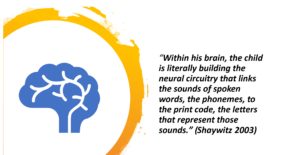
Let’s have a look at the reading brain!
This image shows brain activity in the left hemisphere after a phoneme-grapheme correspondence lesson. Note the activity in the ‘After’ image of the left hemisphere.

So what is our brain doing?
Cognitive neuroscientists and cognitive psychologists have been able to visibly show how the brain responds when learning to read. Our brains are wired to learn to speak by being exposed to language. It is not the same for reading.
Research completed by Dr Stanislas Dehaene, Dr David Kilpatrick and many other prominent researchers has evidenced that areas of the brain can be developed through remediation/ intervention.
Understanding the Reading Brain
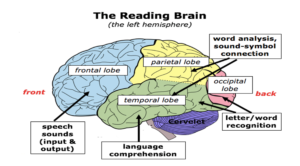
As we have learnt, reading is not something our brains are born to do.
Although the majority have an innate ability to hear sounds and see images, for our ancestors these skills were used to find food and watch out for potential danger. Writing itself is a manmade convention; our brains are not hard-wired to either encode or decode written word. These skills are learned (Sedita, 2020).
It has been found that skilled readers use and integrate several regions of their brain, primarily in the left hemisphere. (Cunningham & Rose; Eden; Hudson et al., 2016)
Scientists have discovered that there are four brain regions that are related to reading:
- he visual cortex that helps us perceive letters and words
- the phonological cortex that maps the sounds to letters
- the semantic cortex that stores word meanings, and
- the syntactic cortex, that helps us understand the rules and structure of sentences
Whilst each part of the brain has a unique role in word reading, they also interact or collaborate to form efficient and fast neural pathways as we read, helping the readers to link printed words with letter sounds and meaning. (Seidenberg, 2018)
The brain is made up of two hemispheres. Each side can be divided into four lobes or regions: frontal, parietal, temporal, and occipital. The left hemisphere of the brain is associated with language processing, speech, and reading.
- Parietal-temporal region– here, written words are segmented into its sounds/ phonemes. Spoken and written words are linked and committed to memory (word analysis, sounding out words). The angular and supramarginal gyrus connect different the parts of the brain so that letter shapes can be combined to make words.
- Occipital-temporal region – this is where the brain stores the appearance and meaning of words. The Occipital lobe is important in the identification of letters. The Temporal Lobe supports verbal memory. (letter-word recognition, automaticity, and language comprehension).
- Frontal region – Where the Broca’s area governs speech and language comprehension (processing speech sounds as we listen and speak).
Excerpted from Teaching Reading Sourcebook, Third Edition. Honig B., Diamond L. & Gutlohn, L. (© 2018 by CORE)
Neuroscientists have found that reading ability in young children is directly related to the growth of white matter in the brain. This matter, known as “myelin”, transmits messages across the brain at lightning speed.
It is thought that the right hemisphere of the brain tries to compensate for the phonological deficit of the struggling reader by remembering whole words. This has been proven to be the opposite of what a skilled reader will do. The skilled reader will learn via the phonological and orthographic pathways. (Kilpatrick, 2015)
View the following three videos explaining how the brain learns to read.
The Reading Brain | How We Learn To Read – YouTube
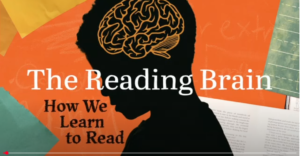
How the Brain Learns to Read – Prof. Stanislas Dehaene – YouTube
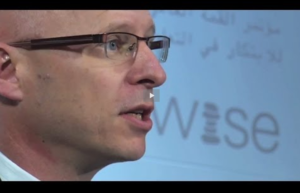
What We Know About Reading and the Brain | Reading Rockets
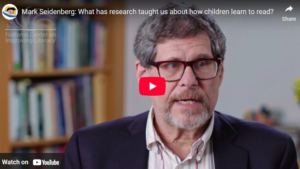
How does science inform our teacher knowledge and practices?
Neuroscience has also informed us, that for a child to learn to read, they have to understand that, spoken words can be pulled apart into particles of speech (phonemes), and that the letters / letter combinations (graphemes) in written words represent these sounds. (2018, Mollway).
To achieve fluency when reading, students must develop orthographic processing, the ability to mentally recognize, create, store, and instantaneously retrieve the visual representation of written words.
Successful readers and spellers have well developed phonological processing and can easily “sound out” unfamiliar words. They then use visual memory, or orthographic processing, to retain the way printed words look. As a result, the frequency in which they need to sound out words lessens. They recognise words, as if by sight, because they are stored in their Sight Word /Orthographic Lexicon.
Successful readers can also apply their knowledge to attempt variations of words despite not having seen them before i.e. ‘behave’ to ‘behaviour’. (Refer to David Share’s – Self Teaching Hypotheses). They also utilize their imagery for words to accurately spell words like ‘beautiful’ that do not follow phonetic rules.
Self-Teaching Hypothesis (David Share,1995)
The self-teaching hypothesis, proposed by David Share, is the idea that once learners have established their knowledge of grapheme-phoneme correspondences and the essential process of segmenting and blending, they begin to apply this knowledge to new and novel words. (Links attached for your interest)
The self teaching hypothesis – Five from Five
Phonological recoding and self-teaching: sine qua non of reading acquisition – ScienceDirect
How the Brain Learns to Read – Keys to Literacy
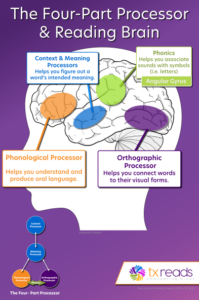
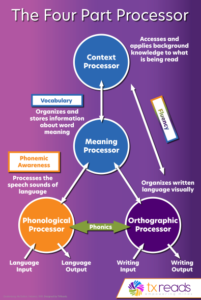
Four Part Processing Model & Reading Brain (Image created by TX Reads, adapted from on Brain Systems for Reading, Shaywitz, 2003.p.78, Fig.2)
Four Part Processing Model (Image created by TX Reads, adapted from Seidenberg, McClelland, 1989)
Four-Part Processing Model
The Four-Part Processing Model for reading is a simplified model that illustrates how the brain reads or recognizes words. It illustrates that there are four processes that are active in the reading brain including: phonological, orthographic, meaning, and context processors (Seidenberg & McCelland 1989).
The ability to read a word accurately and fluently depends on our ability to recognise and isolate individual sounds (phonemes), and our knowledge of phoneme-grapheme correspondences and our ability to blend them together with ease.
The phonological processor which detects, recalls and understands (phonemes) that make up spoken words, works with the orthographic processor which recognises stores and recalls the letters and combination of letters that we use to recognize written language to decode unfamiliar words.
Next the meaning processor interprets word meanings by organising words into meaning networks and finally the context processor supports the meaning processor by interpreting words based on the language of the sentence, experience and knowledge of the concept.
For most of us this occurs effortlessly and without our knowledge but for our early learners it must be explicitly taught. The evidence shows that instruction should occur for students to address all processors, so that as each processor is strengthened, all processors will work together.
Structured Literacy is instruction based on what science has taught us about how child ren learn to read. Teaching students’ phonology, sound-symbol relationships, and syllables is needed to develop word recognition skills. Teaching morphology, syntax, and semantics addresses language comprehension.
A teacher who understands how the reading brain works will teach these skills in an explicit manner where skills are directly taught by the teacher, students are given many opportunities for practice, and teachers give prompt, corrective feedback.
The teaching is systematic and cumulative, with skills taught in a defined sequence built around the structure of the English language. The easiest, most frequently occurring skills are taught first, and the more difficult concepts build on these previously taught concepts.
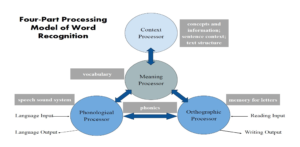
In summary, the phonological and orthographic processors must work together to decode a word. Once the word is decoded, the process moves to the meaning processor where pre-established links or connections are used to determine meaning. A deep knowledge of vocabulary is helpful. Finally, the context processor must work with the meaning processor to determine the appropriate meaning. The structure within which the word appears and the happening within the text supports this nuanced process.
